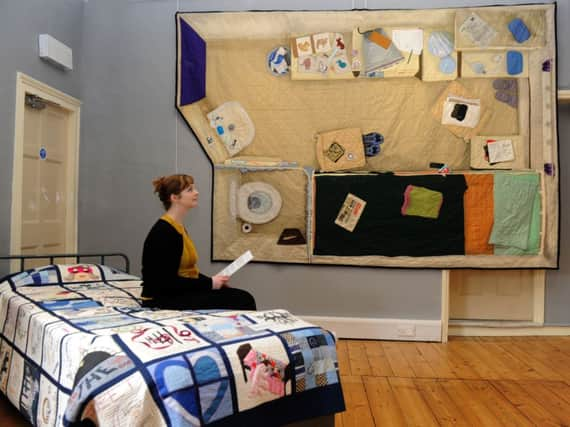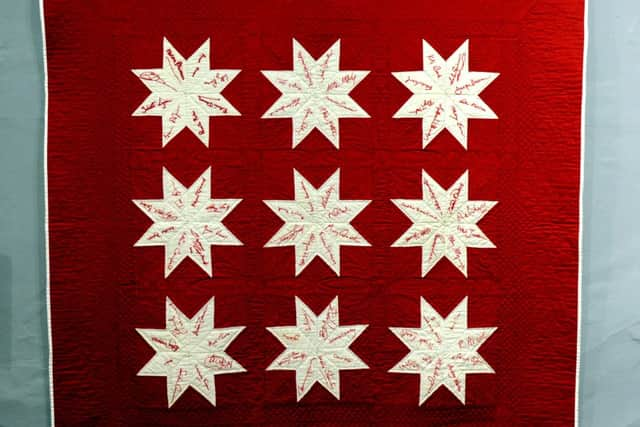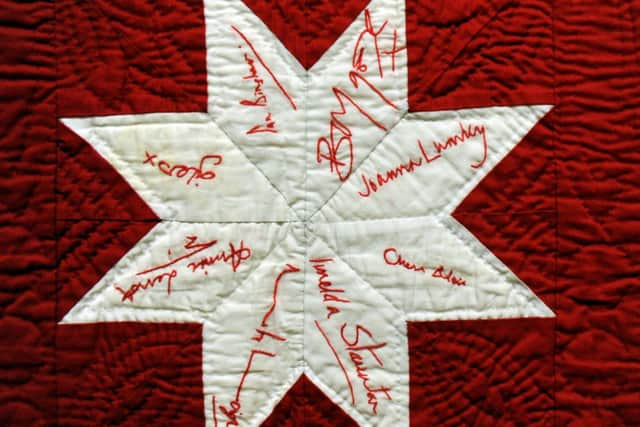Within these padded walls


Running along one side is a bed, in the corner is a sink and opposite someone has stitched a small table. Measuring 6ft by 8ft, the cloth is a bird’s eye view of a British jail cell and has been painstakingly stitched by a serving prisoner.
The work is one of a number of pieces in the Voices from the Inside exhibition which have all been completed as part of the Fine Cell Work project. The social enterprise was founded in 1997 by Lady Ann Tree, who first began visiting prisons in the 1960s, and now boasts 60 volunteers training over 400 prisoners in 29 jails across England.
Advertisement
Hide AdAdvertisement
Hide Ad“Embroidery and prison isn’t something you would necessarily put together,” says curator Heather Audin. “However, Fine Cell Work had been on our radar for some time partly because the work challenges preconceptions. We knew that we would like to feature some of the pieces made by prisoners, the question was how and when. Some of the work is incredibly thought provoking and it offers a real insight into what life is like behind bars in British prisons.”


After a long battle with the Home Office, Lady Tree managed to convince the Government that prisoners trained by Fine Cell Work should be paid for the pieces they produce. However, while the best of their efforts have recently been sold both online and through a pop-up shop housed in Fortnum and Mason, this is the charity’s first solo show.
“Visitors tend to be most struck by the floorplan, which is much smaller than people think,” adds Heather. “It conjures up a real sense of claustrophobia and while this is not about asking for sympathy for those who have been sent to prison it is about exploring the realities of a life inside. All the work which has been done under the Fine Cell Work scheme is incredibly intricate. Quilting requires a great deal of concentration and as works of art alone these pieces are worth seeing.”
“It shows what can be achieved in the austerity of prison and the work is a real reminder of the power crafts like this can have,” adds museum manager Shirley Collier. “Being able to host their first exhibition is a real coup for us in York and we hope it makes a real impact.”
Advertisement
Hide AdAdvertisement
Hide AdThe Fine Cell Work exhibition also includes a piece commissioned for fashion designer Stella McCartney’s private collection, a tribute to service personnel killed in action designed for the Help the Heroes charity and a quilt which was made for a widow out of her late husband’s ties.


“He had quite a collection apparently and his wife wanted something which would be a permanent reminder of him,” says Heather. “The prisoner who made it said he felt honoured to be trusted with something which was so personal. Giving individuals that kind of responsibility is something Fine Cell Work is keen on. It’s about helping people develop the kind of skills which might be useful on the outside.”
The museum is housed in the Quilters’ Guild, but after struggling with funding this year will mark the last full public exhibitions. Come October, the museum will close its doors, but the guild’s extensive collection will still be available to view by appointment.
“It is a shame, particularly given the real renaissance crafts like quilting have enjoyed over recent years,” says Heather. “However, the collection is not going anywhere and anyone who wants see specific pieces just needs to contact us.”
Advertisement
Hide AdAdvertisement
Hide AdThe Fine Cell Work display is running alongside another exhibition showcasing 23 pieces from the guild’s historic collection, which spans more than two centuries. All Shapes and Sizes celebrates the design and draughtmanship skills of quilters through the ages and includes everything from a 1960s patchwork bikini to a 19th century work made from 2,000 individual hexagons.
“It’s quite staggering to think that many of these quilts were pieced by makers who most certainly would not have had access to the tools and knowledge that today’s quilters take for granted,”says Heather, who while a skilled dressmaker admits the fine art of quilt-making is beyond her talents. “Most were made by women, who despite having had little access to an education in maths, showed an incredible talent for quite complex geometry. I did give it a go once, but I knew pretty quickly that I didn’t have the eye or the patience for it.
“With quilting, if you get one piece wrong, it throws the entire work completely out of shape. Quite how they achieved such precision with such limited resources baffles quilt enthusiasts and is a topic of much debate in craft circles. If only quilts could talk...”
• The Quilt Museum and Gallery, Peasholme Green, York, is open Monday to Saturday, 10am-4pm. Both exhibitions run to May 9 and for more details visit www.quiltmuseum.org.uk